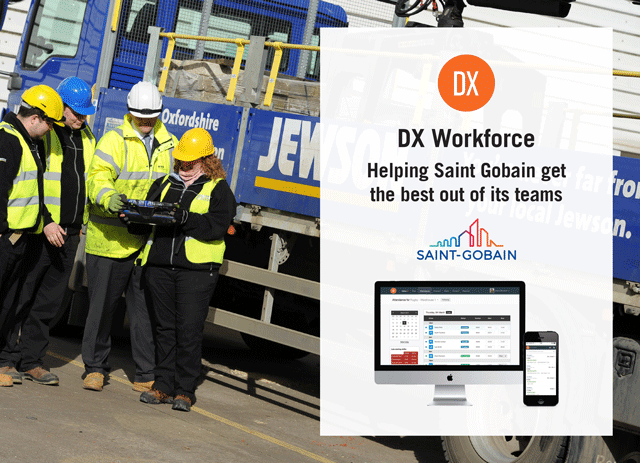
Saint-Gobain knew it needed a joined-up approach to driver agency requirements, so it turned to Driver Exchange and together they proved to the judges a successful use of technology
When it comes to winning the Best Use of Technology Award it is worth remembering that key word: use. The judges were not looking for the best technology, or the most exciting out-there ideas; it’s the practical application of technology to the everyday success of a logistics and distribution business.
That is exactly what Driver Exchange delivered for Saint-Gobain. The construction materials giant – which counts the likes of Jewson, British Gypsum and Isover among its many brands – was experiencing some challenges with its agency driver model across its 1,100 UK branches, so much so that it tendered for a new management across the piece.
That’s where Driver Exchange, alongside Southampton-based driver recruitment agency HGMS, stepped in. Driver Exchange was set up by Adam Thompson, Harry Blundun and George Campbell-Collins in September 2011, and it took several years of development and testing until it started trading in early 2014. Now it counts the likes of Tradeteam and Tarmac among its growing customer base.
Business case
Thompson and Campbell-Collins know their way around the driver recruitment business – having founded Milestone in 2005. It went on to become the second largest driver recruitment business in the UK, with a turnover of circa £50m providing more than 2,000 agency driver shifts nationwide every day, before it was bought by Staffline in September 2015.
But it wasn’t just the pedigree of the management team that saw Driver Exchange and HGMS win that tender with Saint-Gobain – it was the application of the technology to its business. “In terms of what we are doing it is not the most bleeding-edge technology out there – but it is well applied technology with a water-tight business case,” said Thompson. “They are experts at selling bricks and mortar,” he said of the many subcontractors that run the multitude of Saint-Gobain brand sites. “They are not run by highly experienced transport operators. That meant before Driver Exchange came along, there was a huge spend on drivers all around the country.”
Wasting money
Indeed, Saint-Gobain lacked a joined-up national view of its agency driver requirements. This meant it was wasting thousands of pounds paying for ad-hoc drivers at one site, while another would have drivers standing around doing nothing. Furthermore, there was a lack of control among managers, as they had no oversight on this over-ordering of driver resources.
This was compounded by the ‘wrong drivers’ problem: Saint-Gobain and its previous agencies had a large number of complex variables to juggle to get the right driver to the right site – anything from guaranteed hours to distance from home and qualifications for use of specific items of kit. This added cost into the business, especially in unused contracted hours.
Exacerbating the issues at Saint-Gobain was its reliance on paper and email-based timesheets. The agencies were notified of driver requirements by telephone, driver start and finish times were recorded on paper, and these time sheets were used to reconcile costs, often by email. This led to sloppy time-keeping and increased administrative costs.
“We came along and gave a solution,” said Thompson. That solution was Driver Exchange’s Vendor Management Software (VMS) – a cloud-based system that manages agency driver bookings; automates charge and pay calculations and gives cost-control and transparency across the entirety of
Saint-Gobain’s national network. After the 2015 tender Saint-Gobain signed the deal in its Paris headquarters and rolled it out in 2016.
Cloud-based
Because it is cloud-based, engineers were not required to install it on every local system throughout its
1,100-site network. As it is hosted on servers in the UK and France, it only requires internet access. Driver Exchange ran a train-the-trainer programme, which meant that roll-out took just three
months.
The software can book agency driver shifts, so the driver gets a text and email confirming their next assignment. It can also handle multiple rate-structures, giving managers real-time information of costs and driver utilisation. It has a time and attendance function that also serves as a pay calculator, which allows SaintGobain to have up-to-the-minute financial reporting of agency driver spend. Approval by
Saint-Gobain’s finance department is a three-stage process – while KPI and finance reports that monitor and manage driver, agency and team performance, as well as spending, is instantly available to managers.

“There is a single view of the world now,” explained Thompson, “everyone has a single version of the truth. In Driver Exchange world when a driver is given the key he gets logged in
through the Driver Exchange system, which calculates their
pay to the penny. If there are any issues, it will get sorted immediately. An issue can be dealt with by the people who know the most about it.”
With a centralised booking system, handling some 400 driver bookings a day, Saint-Gobain’s driver
needs are hard to predict. The booking system allows all regional requirements to be entered and bookings will be filled by a team of planners.
“In Driver Exchange you can sift the type of driver who is the best fit and the closest proximity to the requirement,” said Thompson. That best fit is based not just on skills specific to the terms and conditions of the job, but also on available hours. An authorisation process is built in with Driver Exchange tracking the reasons local branches book drivers, which is then authorised by regional managers via a smartphone. Reason codes, such as holiday or sickness, gives Saint-Gobain the ability to identify sites that are over-booking drivers, and why they are doing it.
Audit trail
Electronic timesheets have a full audit trail, while Driver Exchange has been able to expand
the number of codes used for rates (more than 1,800 are available) while still offering automated, real time pay and charge calculations.
“When we started with Driver Exchange people said ‘are drivers the right people to adopt software through smartphones and get paid by smartphones? Well, someone on the road nearly always has a smartphone. And we found that 78% of drivers’ hours are logged from a mobile device,” said Thompson.
This has led to significant savings at Saint-Gobain: firstly, eliminating the large number of people calling drivers and automating communication through text message has resulted in a £100,000 cost saving. Secondly, reducing the number of drivers standing on pay-no-use hours, and matching them with locally available drivers, has led to a £210,000 saving.
Furthermore, reducing over-buying of drivers has delivered savings of £175,000. Closer timesheet control has led to £92,000 of costsavings – while Driver Exchange said it is impossible to know what the savings are regarding its automated driver pay calculations. It adds up to a saving of £577,000 in its first year of full operation on £7m of agency spend. Even better, is an increase in the agency driver fulfilment rate of 80% to 98.5%.











